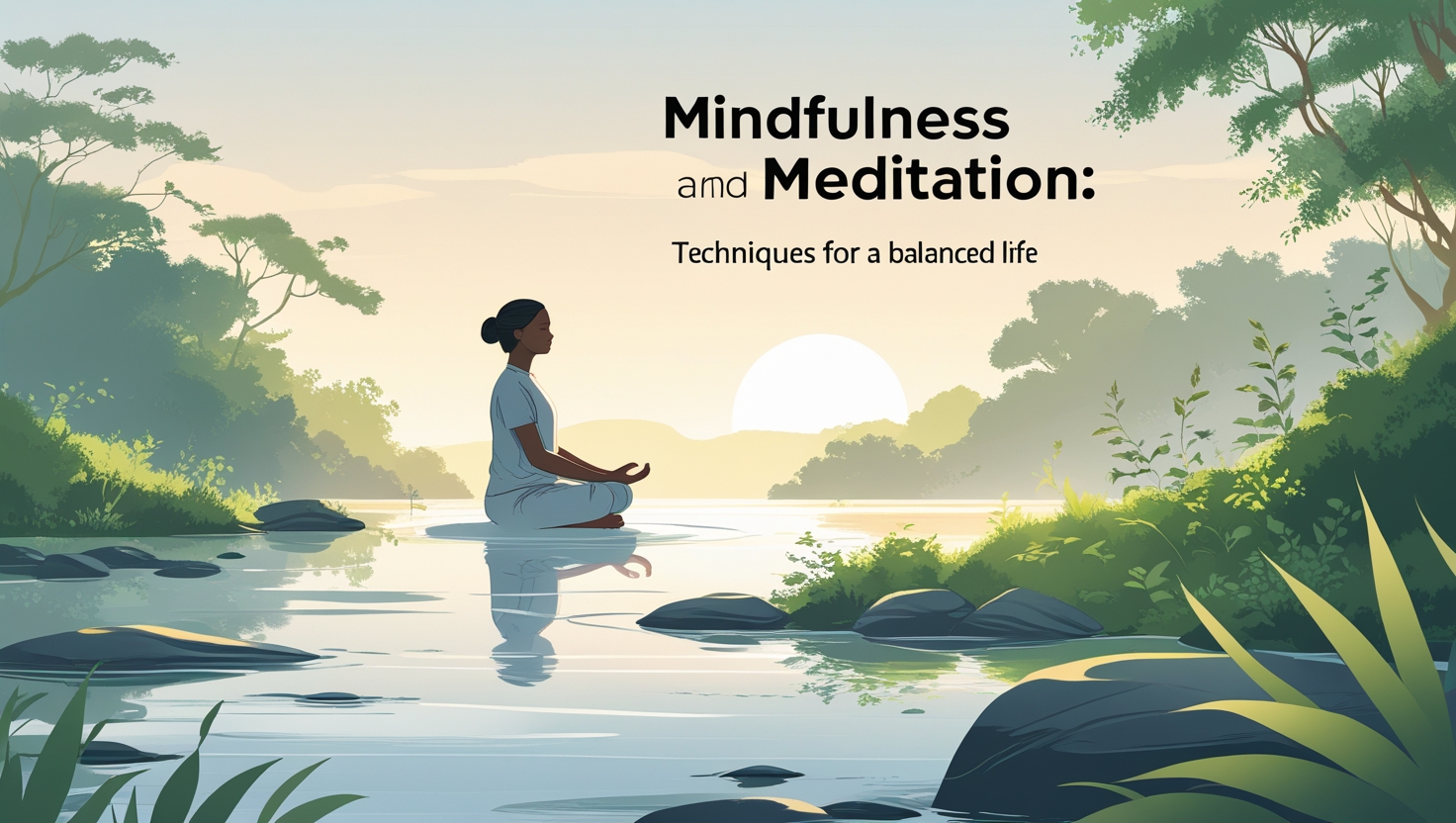Introduction
In today’s fast-paced world, stress, anxiety, and the constant distractions of modern life can leave us feeling overwhelmed and disconnected from our inner selves. Many people are now turning to mindfulness and meditation as effective ways to regain balance, cultivate mental clarity, and enhance overall well-being. Whether you’re new to these practices or have been exploring them for years, this comprehensive guide will provide you with proven techniques and practical tips to help you integrate mindfulness and meditation into your daily life.
Discover Top-Rated Meditation Programs – Boost Your Inner Peace Today!
Understanding Mindfulness and Meditation
What is Mindfulness?
Mindfulness is the practice of paying deliberate attention to the present moment with an attitude of openness, curiosity, and non-judgment. It means being fully engaged in what you are doing, whether it is eating, walking, or simply breathing, without being distracted by past regrets or future worries.
Key aspects of mindfulness include:
- Awareness: Being conscious of your thoughts, feelings, and physical sensations.
- Presence: Focusing your attention on the here and now.
- Acceptance: Embracing your experiences without trying to change them immediately.
What is Meditation?
Meditation is a structured practice that typically involves focusing attention and eliminating the stream of thoughts that may crowd your mind. Through regular meditation, individuals can achieve a state of inner calm, improved concentration, and a deeper understanding of themselves. Meditation comes in many forms, ranging from guided sessions with audio assistance to silent, self-directed practice.
Some common meditation practices include:
- Breathing Meditation: Focusing solely on your breath.
- Mantra Meditation: Repeating a word or phrase to help center your thoughts.
- Visualization: Creating mental images to promote relaxation.
- Mindfulness Meditation: Combining mindfulness techniques with focused meditation.
Benefits of Mindfulness and Meditation
The benefits of mindfulness and meditation extend well beyond stress relief. Numerous studies have shown that regular practice can lead to significant improvements in mental, emotional, and physical health. Here are some key benefits:
- Stress Reduction: Both mindfulness and meditation have been proven to lower cortisol levels (the stress hormone), helping you manage stress more effectively.
- Improved Concentration: Regular practice sharpens focus and enhances cognitive function.
- Enhanced Emotional Well-Being: These practices promote a greater sense of calm, reduce symptoms of anxiety and depression, and foster emotional resilience.
- Better Sleep Quality: Mindfulness can help quiet the mind, making it easier to fall asleep and enjoy deeper, more restorative sleep.
- Increased Self-Awareness: By paying attention to your thoughts and emotions, you can gain valuable insights into your behavioral patterns and improve your self-understanding.
- Physical Health Benefits: Meditation can lower blood pressure, improve immune function, and reduce chronic pain.
For additional strategies on reducing stress, check out our article on 10 Proven Strategies to Reduce Stress and Improve Sleep Quality.
Daily Mindfulness Techniques
Incorporating mindfulness into your daily routine does not require a significant time commitment. With a few simple practices, you can begin to experience the transformative benefits of living in the moment.
1. Mindful Breathing
Mindful breathing is one of the simplest and most effective ways to practice mindfulness. By focusing on your breath, you can bring your attention to the present moment and reduce mental clutter.
How to Practice:
- Find a comfortable seated position.
- Close your eyes and take slow, deep breaths.
- Focus on the sensation of the air entering and leaving your nostrils.
- If your mind wanders, gently bring your focus back to your breath.
- Practice for 5-10 minutes each day.
2. Body Scan Meditation
The body scan meditation involves mentally scanning your body for tension and consciously releasing it. This practice enhances body awareness and promotes relaxation.
How to Practice:
- Lie down in a quiet, comfortable space.
- Close your eyes and focus on your breathing.
- Start at the top of your head and slowly move down to your toes.
- Notice any areas of tension, and consciously relax those muscles.
- Spend 1-2 minutes on each body part.
3. Mindful Eating
Mindful eating transforms mealtime into a meditative practice. By focusing on the taste, texture, and aroma of your food, you can develop a healthier relationship with eating.
How to Practice:
- Sit down at a table without distractions (no TV or smartphones).
- Take small bites and chew slowly.
- Savor the flavors and textures of your food.
- Notice how your body feels before, during, and after eating.
4. Walking Meditation
Walking meditation is an excellent way to combine physical movement with mindfulness. It allows you to focus on each step, turning an everyday activity into a mindful practice.
How to Practice:
- Choose a quiet, safe place for a short walk.
- Walk slowly and pay attention to each step.
- Focus on the sensation of your feet touching the ground.
- Breathe deeply and notice the sights, sounds, and smells around you.
5. Gratitude Journaling
Gratitude journaling is a powerful mindfulness practice that shifts your focus toward the positive aspects of your life. It helps you cultivate an attitude of appreciation and contentment.
How to Practice:
- At the end of each day, write down three things you are grateful for.
- Reflect on why these things are important to you.
- Notice how this practice affects your mood and perspective over time.
Various Meditation Practices
Different meditation techniques offer unique benefits and suit various personal preferences. Here are several popular practices to consider:
6. Guided Meditation
Guided meditation uses audio or video instructions to help you focus and relax. It’s particularly useful for beginners who need direction.
How to Practice:
- Choose a guided meditation session from a trusted app or online source.
- Find a quiet space where you won’t be disturbed.
- Follow the instructions, allowing the guide to lead you through the meditation.
7. Loving-Kindness Meditation
Loving-kindness meditation, also known as Metta meditation, focuses on cultivating compassion and love for oneself and others. This practice can enhance emotional resilience and empathy.
How to Practice:
- Sit comfortably and close your eyes.
- Begin by silently repeating phrases such as “May I be happy, may I be healthy, may I be safe.”
- Gradually extend these wishes to include loved ones, acquaintances, and even those with whom you have difficulties.
- Spend several minutes on each stage.
8. Transcendental Meditation
Transcendental Meditation (TM) is a mantra-based practice that aims to transcend ordinary thinking and access a state of deep rest and awareness. TM is known for its simplicity and effectiveness in reducing stress.
How to Practice:
- Sit comfortably with your eyes closed.
- Silently repeat a chosen mantra.
- Allow your mind to settle into a state of effortless awareness.
- Practice for 20 minutes twice daily (TM courses are typically guided by certified instructors).
9. Zen Meditation (Zazen)
Zen meditation, or Zazen, is a traditional Buddhist practice that emphasizes seated meditation, focusing on breath and posture to achieve mental clarity.
How to Practice:
- Sit in a comfortable position, preferably on a cushion with your legs crossed.
- Keep your back straight and your hands in a meditative position.
- Focus on your breathing, letting go of distracting thoughts.
- If thoughts arise, simply acknowledge them and return your focus to your breath.
10. Visualization Meditation
Visualization meditation involves creating vivid mental images that evoke a sense of peace and calm. It can be a powerful tool for stress relief and goal setting.
How to Practice:
- Sit comfortably and close your eyes.
- Visualize a peaceful scene, such as a beach at sunset or a quiet forest.
- Engage your senses by imagining the sounds, smells, and sensations of the scene.
- Allow the calming image to fill your mind for several minutes.
Discover the Best Guided Meditation Apps – Start Your Journey to Inner Peace!
Integrating Mindfulness and Meditation into a Busy Life
While the benefits of mindfulness and meditation are profound, many people struggle to integrate these practices into their hectic schedules. The key is to start small and build consistency over time.
Create a Daily Routine
- Set Aside Time: Dedicate just 10-15 minutes each day to mindfulness or meditation. Over time, gradually increase the duration as you become more comfortable.
- Morning or Evening Ritual: Incorporate mindfulness into your morning routine to set a positive tone for the day, or use meditation in the evening to unwind and prepare for restful sleep.
- Use Reminders: Set reminders on your phone or place visual cues in your living space to encourage you to practice regularly.
Combine with Daily Activities
- Mindful Moments: Practice mindfulness during routine activities such as showering, washing dishes, or commuting.
- Work Breaks: Use short breaks at work to practice deep breathing or a quick body scan.
- Technology Aids: Utilize smartphone apps that send reminders or provide short meditation sessions to help you stay on track.
Overcome Common Challenges
- Busy Mind: If your mind is constantly busy, acknowledge your thoughts without judgment and gently return to your practice.
- Lack of Time: Even short periods of mindfulness can be beneficial. Consistency is more important than duration.
- Finding a Quiet Space: Create a small, dedicated area in your home where you can practice without interruptions.
For more techniques on managing daily stress, read our article on 10 Proven Strategies to Reduce Stress and Improve Sleep Quality.
Expert Advice and Additional Resources
Numerous studies and expert opinions back the benefits of mindfulness and meditation. Here are a few insights from experts:
- Dr. Jon Kabat-Zinn, a pioneer in mindfulness-based stress reduction (MBSR), emphasizes that mindfulness is about paying attention in a particular way—on purpose, in the present moment, and non-judgmentally.
- Neuroscience Research shows that regular meditation can increase grey matter in areas of the brain associated with learning, memory, and emotion regulation.
- Mindfulness-Based Cognitive Therapy (MBCT) has proven effective in preventing the recurrence of depression and improving overall mental health.
Additional Resources:
- Books: “The Miracle of Mindfulness” by Thich Nhat Hanh and “Wherever You Go, There You Are” by Jon Kabat-Zinn.
- Apps: Explore popular mindfulness apps like Headspace and Calm.
- Online Courses: Many platforms offer courses on mindfulness and meditation to guide you through the process.
Subscribe Now for Exclusive Mindfulness Courses and Meditation Programs – Empower Your Mind!
Mind-Body Connection: The Impact on Overall Health
Integrating mindfulness and meditation into your daily routine can have far-reaching effects on your physical, mental, and emotional health. Here are some key aspects of the mind-body connection:
- Improved Immune Function: Reduced stress levels can enhance immune response and lower the risk of illness.
- Enhanced Cognitive Function: Regular meditation improves concentration, memory, and overall brain health.
- Emotional Resilience: Mindfulness helps regulate emotions, reducing anxiety and depressive symptoms.
- Better Physical Health: Lower stress and increased relaxation can reduce chronic pain, improve cardiovascular health, and promote better sleep.
This holistic approach not only nurtures mental clarity but also supports physical vitality.
For further reading on boosting your immune system naturally, check out How to Boost Your Immune System Naturally.
Case Studies and Success Stories
Many individuals have experienced transformative changes in their lives through regular mindfulness and meditation practice. Here are a few real-life examples:
Case Study 1: Reducing Workplace Stress
A corporate professional struggled with high levels of work-related stress and burnout. After incorporating 10 minutes of mindful breathing and a short body scan into his daily routine, he reported:
- Increased focus and productivity at work.
- Improved mood and reduced anxiety.
- Better sleep quality and overall energy levels.
Case Study 2: Overcoming Anxiety
A college student suffering from anxiety began practicing loving-kindness meditation daily. Over several months, she noticed:
- A decrease in anxiety symptoms.
- Greater compassion toward herself and others.
- Enhanced social interactions and a more positive outlook on life.
Case Study 3: Improving Emotional Well-Being
An individual coping with chronic depression found solace in guided meditation and gratitude journaling. The regular practice led to:
- A gradual improvement in mood.
- Increased emotional stability.
- A stronger sense of self-worth and inner peace.
These success stories underscore the practical benefits of adopting mindfulness and meditation in everyday life.
Overcoming Barriers to Practice
Even with the proven benefits, starting and maintaining a mindfulness or meditation practice can be challenging. Here are some common barriers and tips to overcome them:
- Lack of Time: Even short practices can be effective. Start with 5 minutes and gradually build your practice.
- Distracting Thoughts: It is normal for the mind to wander. Acknowledge distractions and gently return your focus to your breath or chosen point of concentration.
- Feeling Self-Conscious: Find a private space where you feel comfortable. With practice, you may even join group sessions or classes.
- Skepticism About Effectiveness: Consider trying a guided session for a week to experience firsthand how meditation can improve your mood and reduce stress.
Explore Our Recommended Mindfulness Tools and Apps – Get Started Today!
Final Thoughts and Action Steps
Incorporating mindfulness and meditation into your daily routine is a powerful way to create a more balanced and fulfilling life. The techniques outlined in this guide—from mindful breathing to guided and loving-kindness meditation—offer practical tools to reduce stress, improve mental clarity, and foster emotional resilience.
Action Steps:
- Start Small: Dedicate just 5-10 minutes a day to mindfulness or meditation.
- Choose Your Technique: Experiment with different practices until you find the ones that resonate with you.
- Create a Routine: Integrate mindfulness into your daily activities, whether through meditation, journaling, or mindful walking.
- Track Your Progress: Keep a journal to record how these practices impact your mood, sleep, and overall well-being.
- Seek Resources: Use apps, online courses, or join local groups to deepen your practice.
- Combine with Healthy Habits: Pair your mindfulness routine with proper nutrition, regular exercise, and sufficient sleep to maximize the benefits.
Remember, consistency is key. As you continue to practice, you will likely notice improvements not only in your mental and emotional health but also in your physical well-being.
Transform Your Life with Our Exclusive Mindfulness and Meditation Free E-Book
Subscribe to Pro Health Channel Now!
For more tips on achieving a balanced life, be sure to explore our other articles on Pro Health Channel. Whether you’re looking to boost your immune system, reduce stress, or improve your overall health, our curated content provides actionable advice and expert insights to guide you on your wellness journey.
Share this content:








2 Comments